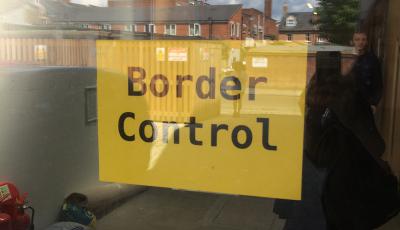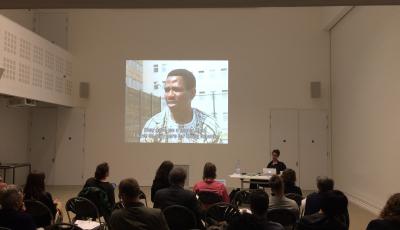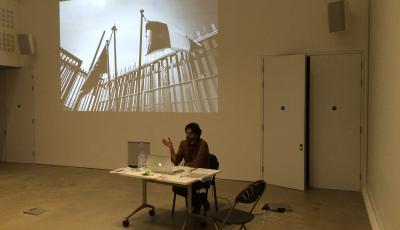Post by Sarah Turnbull, Centre for Criminology, University of Oxford. Follow Sarah on Twitter @SL_Turnbull.
On Monday, 23 May 2016 at the Ruskin School of Art, Border Criminologies hosted a workshop that brought together artists who work inside spaces of incarceration and immigration detention. Part of Mary Bosworth’s ERC-funded ‘Subjectivity, Identity and Penal Power’ project, the event was organised by Khadija von Zinnenburg Carroll and Jessyca Hutchens to consider the aesthetics of border control and critically explore issues of confinement, censorship, and the power of archival and photographic evidence. The integration of and engagement with visuals and material culture is one of the broad aims of Border Criminologies and the day provided an important avenue to consider these issues.

Next, Khadija presented her work on experience of exile and the borders of Europe, and described how she’s been working to make public the Immigration Detention Archive. She screened an early version of the film she’s been working on that portrays the archive in the context of the detention centre art room through the use of testimonies, bureaucratic paperwork, drawings, and videos made during photography and video workshops she ran in Colnbrook IRC. Khadija discussed some of the challenges of working as an artist and researcher inside institutions of immigration and object oriented academic study. She used the example of one of the visual strategies evidenced in Colnbrook’s media room―‘cutting’ in Photoshop―in which detainees take photographs of themselves and insert them into various backgrounds (e.g., the London skyline, the English Gentleman’s Club, etc.), to highlight the contradictions in representations, and the ultimate failure of liberal claims to art-making as redemptive.
As a respondent to the presentations by Mary and Khadija, Jessyca, a Charlie Perkins scholar at the Ruskin School of Art who’s researching the topic artists in residence, commented on the issue of temporalities in detention and how this impacts engagement with art and its representation. In discussion, questions focused on the practicalities of running workshops in immigration detention, the use of an ‘artist in residence’ function at Campsfield House IRC, the inclusion of literary material in the Detention Archive, and ethical questions about collecting the material for the Archive and its use.
During the lunch break, several works of arts were screened for the workshop attendees: James Bridle’s Seamless Transitions, Laura Poitras’ The Program, and David Rych’s Sans Papiers. David also made available Border Act for viewing using a virtual reality headset.

Respondent Oraib Toukan, a DPhil student at the Ruskin School of Art whose research examines film reels from former Soviet cultural centres in Jordan, facilitated a lively discussion on questions of truth, representation, and ethical questions about the use of participant-generated materials in artist work.
Next to speak was Edmund Clark, an artist who’s currently the artist in residence at HMP Grendon, an English prison with six wings operating as autonomous therapeutic communities. He presented on his previous work on different carceral sites and practices (i.e., control orders and extraordinary rendition), showing photographs from these works as well as related documents and art installations. Edmund explained his role at HMP Grendon, which is to (a) facilitate the making of art and photographs with prisoners and (b) making a body of work in response to the prison.
In response to Edmund’s presentation, Jonathan Watkins, Director of Ikon Gallery in Birmingham, facilitated a discussion that explored such issues as the distinction between therapeutic art and fine art in carceral sites. Edmund elaborated on the challenges and opportunities of working with prisoners at HMP Grendon within the specific rules of the prison and the therapeutic communities.

Respondent Michal Murawski, a postdoctoral research fellow at University College London, led a discussion that focused on artists’ decisions about how to photograph and represent their subjects and ethical issues regarding the photographer-subject relationship. For Mario, it’s important to be open and transparent about the motivations and reasons for the work with subjects.
The final session of the day featured a presentation by Laura Saunders, a documentary filmmaker and artist who works on issues of asylum, borders, immigration detention, and internment. While showing a mixture of video, photographs, and archival images, Laura talked about her work relating to sites of confinement and the complex interconnections between historical practices (i.e., the colonial displacement of indigenous peoples and the internment of Japanese Americans during WWII) and contemporary forms of migrant detention and border control. (See Laura’s blog post about her project, ‘Tracing Gila River,’ here.)
In response to Laura’s presentation, Mary raised the issue of how artists respond to the role of law in developing their art and how we can link pasts practices to contemporary forms of incarceration. Final words by Khadija and Mary underscored the importance of putting issues of art, theory, and confinement in conversation―one of the central achievements of the day.
Note: The workshop was recorded with the aim to have podcasts available on Border Criminologies’ iTunes account. Check back soon!
Any comments about this post? Get in touch with us! Send us an email, or post a comment here or on Facebook. You can also tweet us.
__________
How to cite this blog post (Harvard style):
Turnbull, S. (2016) Border Control: Artists’ Responses to Incarceration. Available at: https://www.law.ox.ac.uk/research-subject-groups/centre-criminology/centreborder-criminologies/blog/2016/05/border-control (Accessed [date]).
Share:








